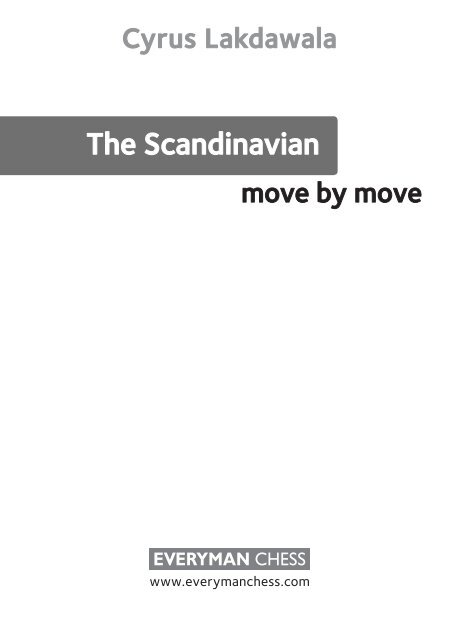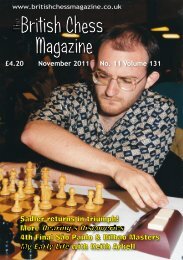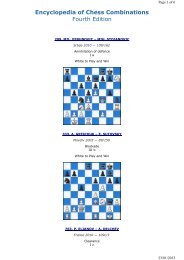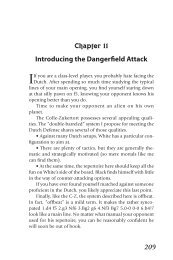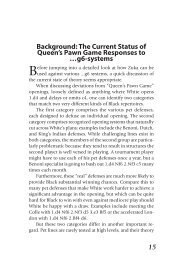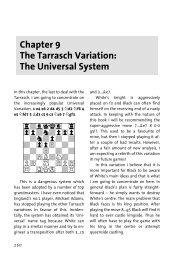Download sample pages. (pdf) - New In Chess
Download sample pages. (pdf) - New In Chess
Download sample pages. (pdf) - New In Chess
Create successful ePaper yourself
Turn your PDF publications into a flip-book with our unique Google optimized e-Paper software.
Cyrus Lakdawala<br />
The Scandinavian<br />
move by move<br />
www.everymanchess.com
About the Author<br />
Cyrus Lakdawala is an <strong>In</strong>ternational Master, a former National Open and American Open<br />
Champion, and a six-time State Champion. He has been teaching chess for over 30 years,<br />
and coaches some of the top junior players in the US.<br />
Also by the Author:<br />
Play the London System<br />
A Ferocious Opening Repertoire<br />
The Slav: Move by Move<br />
1...d6: Move by Move<br />
The Caro-Kann: Move by Move<br />
The Four Knights: Move by Move<br />
Capablanca: Move by Move<br />
The Modern Defence: Move by Move<br />
Kramnik: Move by Move<br />
The Colle: Move by Move
Contents<br />
About the Author 3<br />
Series Foreword 6<br />
Bibliography 7<br />
<strong>In</strong>troduction 9<br />
1 The Main Line without 6 Ìe5 20<br />
2 The 7 Ìc4 Variation 79<br />
3 The 7 Íf4 Variation 120<br />
4 Shirov’s Variation: 7 f4 172<br />
5 Fifth Move Alternatives 217<br />
6 The Early ...c6 Move Order 250<br />
7 The 5...g6 Scandinavian 265<br />
8 White Refrains From an Early d4 293<br />
9 White Avoids an Early Ìc3 331<br />
10 Odds and Ends 363<br />
<strong>In</strong>dex of Variations 393<br />
<strong>In</strong>dex of Games 399
Series Foreword<br />
Move by Move is a series of opening books which uses a question-and-answer format. One<br />
of our main aims of the series is to replicate – as much as possible – lessons between chess<br />
teachers and students.<br />
All the way through, readers will be challenged to answer searching questions, to test<br />
their skills in chess openings and indeed in other key aspects of the game. It’s our firm belief<br />
that practising your skills like this is an excellent way to study chess openings, and to<br />
study chess in general.<br />
Many thanks go to all those who have been kind enough to offer inspiration, advice and<br />
assistance in the creation of Move by Move. We’re really excited by this series and hope that<br />
readers will share our enthusiasm.<br />
John Emms,<br />
Everyman <strong>Chess</strong><br />
6
<strong>In</strong>troduction<br />
My happy association with the Scandinavian began in the mid 1980’s (it comes as quite a<br />
shock to suddenly realize you have been playing an opening since Ronald Reagan’s presidency).<br />
I was paired with the black pieces against the monster 2600-rated IM, and friend,<br />
Doug Root, who I trailed in the tournament standings by a half point and rating wise by<br />
over 100 points. I had never beaten him, and my two defences, French and Alekhine’s, felt<br />
woefully inadequate. He opened the game with 1 e4. Then a Cat Stevens song (before he<br />
became Yusuf Islam!) suddenly popped into my head: “I’m looking for a hard headed woman,<br />
one that will make me do my best. And when I find my hard headed woman, I know the<br />
rest of my life will be blessed, oh yes, yes it will!”<br />
So based on this intuitive data alone, as if by its own volition, my right hand impulsively<br />
reached out for my d-pawn and to my horror pushed it two squares, and soon my hard<br />
headed woman emerged on d5 (and yes, I realize that by making this confession, you now<br />
regard your writer as slightly unbalanced).<br />
W________W<br />
[rhb1kgn4]<br />
[0p0W0p0p]<br />
[WDWDWDWD]<br />
[DWDpDWDW]<br />
[WDWDPDWD]<br />
[DWDWDWDW]<br />
[P)P)W)P)]<br />
[$NGQIBHR]<br />
W--------W<br />
The only Scandinavian game I was familiar with was Larsen’s masterpiece (a 3...Ëa5<br />
Scandi) against Karpov played in Montreal, 1979. <strong>In</strong> an unbelievably good stroke of fortune,<br />
Doug chose the same line as Karpov (the single variation I knew), and overextended, much<br />
the same as Karpov did against Larsen. Well, I was hooked. But the question arose: How did<br />
I arrive in the situation where good fortune bubbled over Was it dumb luck, or was the<br />
9
The Scandinavian: Move by Move<br />
Scandinavian a better opening than people give it credit for I chose to believe the latter. I<br />
didn’t care that at the time (and even today) many strong players considered the Scandinavian<br />
borderline sound. <strong>In</strong> fact, the late GM Rosendo Balinas, after beating down my<br />
Scandi, scolded me: “Your first move was an error!” He warned me that Black’s early queen<br />
excursion walked that precarious tightrope between reason and irrationality. I didn’t believe<br />
him then and I don’t now.<br />
A Violation of all that is Sacred<br />
W________W<br />
[rhbDkgn4]<br />
[0p0W0p0p]<br />
[WDW1WDWD]<br />
[DWDWDWDW]<br />
[WDWDWDWD]<br />
[DWHWDWDW]<br />
[P)P)W)P)]<br />
[$WGQIBHR]<br />
W--------W<br />
With the Scandinavian, we issue a flagrant challenge to long established doctrine. Our<br />
charmed opening mockingly blasphemes against the sacred verities of the most holy of<br />
principles and we must learn to live with a stigma attached. After all, in playing our second<br />
and third moves, ...Ëxd5 and ...Ëd6, Black violates no less than two principles:<br />
1. Don’t bring your queen out early, since your opponent’s pieces or pawns may give<br />
chase, at your loss of time and discomfort.<br />
2. Don’t fall behind in development.<br />
However, normal laws of physics collapse when entering this anomalous pocket of space.<br />
<strong>In</strong> this universe, rapid development and central control are arbitrarily punished, while egregious<br />
violations like bringing out one’s queen early, and moving her over and over again, is<br />
blessed with reward! The Scandinavian is a dark alien technology, which doesn’t function<br />
under any set of mechanical principles with which I am familiar. It’s a bit like the hardworking<br />
government clerk who finishes his work early, and as a consequence must complete<br />
the unfinished work of lazy co-workers. Well, we are the lazy co-workers! The reasons<br />
First, White has a terrible time opening the position any further, since our Caro-Kann<br />
set-up: ...c6, ...Íf5 (or ...Íg4), and ...e6 renders the structure rather rigid, which in turn deflates<br />
White’s much publicized development lead.<br />
Secondly, your opponent lacks specific targets, despite an often massive development<br />
lead.<br />
10
<strong>In</strong>troduction<br />
Lastly, your opponent often believes you are crushed, when in reality he or she may only<br />
hold only a mild ‘+=’ or even ‘=’ assessment.<br />
From my experience our opening represents an agency unconstrained by normal chess<br />
laws, and we, the faithful, are inexplicably granted amnesty for past, unpunished (and future)<br />
crimes, in perpetuity. Ironically, it is precisely our flagrant and defiant violations<br />
which plant the seed for the defeat of our law abiding opponent. Our secret We drizzle<br />
temptation before our opponent’s eyes. It is in his extravagant attempt to bring us to justice<br />
– that very moment is normally when our opponent’s guard finds itself at its lowest<br />
ebb – and it is precisely then that we counter strike, and White finds his rage channelled<br />
into diversionary byways.<br />
Have faith. Our opening is sound. At the time of writing, Black scores just above 46% after<br />
3...Ëd6 – slightly above average for a black opening. So the stats just don’t bear out the<br />
theory that the Scandinavian is some disreputable byway. The opening is legit and here to<br />
stay. When you take it up, you discover a mysterious woman you simply fail to fathom, yet<br />
still love.<br />
Our Great Hurdle<br />
W________W<br />
[rhbDkgW4]<br />
[0pDW0p0p]<br />
[WDp1WhWD]<br />
[DWDWHWDW]<br />
[WDW)WDWD]<br />
[DWHWDWDW]<br />
[P)PDW)P)]<br />
[$WGQIBDR]<br />
W--------W<br />
<strong>In</strong> the diagrammed position, we have little to no margin for error. Our defence must be<br />
comp-perfect or we face Old Testament style divine retribution. We cover this line and its<br />
offspring in Chapters Two, Three and Four. It represents no less than an attempt at total<br />
eclipse of the ...Ëd6 lines and constitutes an existential threat to our very survival. So study<br />
these chapters as if your life depends upon it – because it does! If you do study these chapters<br />
carefully, you discover that your resources are more than adequate against White’s<br />
coming assault.<br />
Here is an early Scandinavian game which caught my eye. Note how Lasker just couldn’t<br />
seem to get his arms around his dream attack.<br />
11
The Scandinavian: Move by Move<br />
1 e4 d5 2 exd5 Ëxd5 3 Ìc3 Ëa5<br />
Game 1<br />
E.Lasker-R.Breckenridge<br />
<strong>New</strong> York (simul) 1894<br />
Question: Aren’t we exclusively covering the 3...Ëd6 lines in this book<br />
Answer: Please keep your voice down or I risk an outraged email from the editor! We are,<br />
but the ...Ëd6 lines didn’t really begin to appear until the 1970’s, so I add this game for a<br />
historical perspective. Even if we don’t cover the ...Ëa5 lines in the book, the middlegame<br />
position reached in this game appears quite similar to many of the structures we will examine.<br />
4 Ìf3 Íg4<br />
4...Ìf6 and 4...c6 are also played here.<br />
5 Íe2<br />
Probably too meek to get much of an edge. 5 h3 Íh5 6 d4 e6 7 g4 Íg6 8 Ìe5 Ìf6<br />
reaches the critical position of the ...Ëa5/...Íg4 Scandinavian. According to theory, White<br />
stands clearly better, but I disagree and defend Black with religious fervour, as do a few<br />
strong GMs, like Christian Bauer.<br />
5...e6 6 0-0 Ìf6 7 d4 c6<br />
Now we reach positions similar to the ones arising from the 3...Ëd6 lines, which we examine<br />
in detail in this book.<br />
8 Ìe5!<br />
W________W<br />
[rhWDkgW4]<br />
[0pDWDp0p]<br />
[WDpDphWD]<br />
[1WDWHWDW]<br />
[WDW)WDbD]<br />
[DWHWDWDW]<br />
[P)PDB)P)]<br />
[$WGQDRIW]<br />
W--------W<br />
He allows Black to swap a bad bishop for White’s good bishop.<br />
8...Íxe2 9 Ìxe2<br />
12
<strong>In</strong>troduction<br />
9 Ëxe2 is, of course, also playable.<br />
9...Íd6<br />
It’s actually better to post the bishop on e7, but they didn’t know this in 1894.<br />
10 f4!<br />
Aggressive and in Lasker’s style, but he also weakens his light squares and places pawns<br />
on the same colour as his remaining bishop, two factors which haunt him later in the<br />
game. I can see why Lasker rejected the boring 10 Ìc4 Ëc7 11 Ìxd6+ Ëxd6.<br />
10...Ìbd7 11 Êh1 Îd8 12 Íd2 Ëc7 13 Ëe1 0-0 14 Ëh4<br />
W________W<br />
[WDW4W4kD]<br />
[0p1nDp0p]<br />
[WDpgphWD]<br />
[DWDWHWDW]<br />
[WDW)W)W!]<br />
[DWDWDWDW]<br />
[P)PGNDP)]<br />
[$WDWDRDK]<br />
W--------W<br />
Question: Isn’t White better He has an entrenched<br />
knight on e5 and looks like he builds an attack as well.<br />
Answer: I actually prefer Black, who controls the central light squares and owns the better<br />
bishop. As for White’s attack, we shall see...<br />
14...Ìe4<br />
The light squares are the commodity to be bartered for and traded.<br />
15 Íe3 Ìdf6 16 Ìd3 Ìd5!<br />
Black’s knights, an infection, begin a slow affliction on the weakened light squares.<br />
17 Îf3<br />
Undaunted by strategic woes, Lasker pushes forward for mate.<br />
17...f5!<br />
Dual purpose:<br />
1. Black anchors his knight on e4.<br />
2. Tossing in ...f5 keeps his king safer since Black begins to challenge White’s kingside<br />
space advantage.<br />
18 Îg1!<br />
Also possible is 18 Îh3 h6 19 Íg1.<br />
13
The Scandinavian: Move by Move<br />
18...Íe7 19 Ëh3!<br />
Consistent, but dubious. Lasker isn’t a likely candidate for the apologetic but correct 19<br />
Ëe1.<br />
19...c5!<br />
W________W<br />
[WDW4W4kD]<br />
[0p1WgW0p]<br />
[WDWDpDWD]<br />
[DW0nDpDW]<br />
[WDW)n)WD]<br />
[DWDNGRDQ]<br />
[P)PDNDP)]<br />
[DWDWDW$K]<br />
W--------W<br />
Principle: Counter in the centre when menaced on the wing. I never heard of Breckenridge<br />
before digging up this game, but he possessed uncanny strategic and defensive instincts<br />
for a person living in his time.<br />
20 Íc1<br />
The bad bishop remains a serious strategic impediment.<br />
20...c4!<br />
20...Ìdf6! is virtually winning after 21 c3 cxd4 22 cxd4 (White also loses after 22 Ìxd4<br />
Ìg4! threatening ...Íc5) 22...Ìg4! 23 Ìg3 Îf6! 24 Ìxe4 Îh6!, picking up material.<br />
21 Ìe5 c3 22 b3 Ìb4<br />
White’s queenside pawns are en prise. He must generate something on the other wing<br />
to compensate, and quickly.<br />
23 Ìg3 Ìxg3+<br />
Houdini likes 23...Ìd6 24 Ìh5 g6 25 g4, but the position around Black’s king begins to<br />
grow turbulent.<br />
24 Îxg3 Ìd5!<br />
He sees through Lasker’s tricks:<br />
a) 24...Ìxc2 drops a piece to 25 Îxc3.<br />
b) 24...Ìxa2 25 Ëh6 Íf6 26 Ía3 when Black must give up an exchange.<br />
25 Îf3<br />
25 Ëh6 leads nowhere after 25...Íf6.<br />
25...Îf6 26 g4 Îh6<br />
Here Lasker’s scheming mind began to weigh the pros and cons of a psycho sac.<br />
27 Ëxh6<br />
14
<strong>In</strong>troduction<br />
W________W<br />
[WDW4WDkD]<br />
[0p1WgW0p]<br />
[WDWDpDW!]<br />
[DWDnHpDW]<br />
[WDW)W)PD]<br />
[DP0WDRDW]<br />
[PDPDWDW)]<br />
[DWGWDW$K]<br />
W--------W<br />
Warfare, by its very nature, offers each side license to inflict savage acts upon the other,<br />
which would be deemed criminal in times of peace. Chaos asserts itself. Out of nowhere,<br />
the queen materializes on h6, as if beamed down by Scotty himself, from the USS Enterprise.<br />
She plunges into the murky depths, without thought of retreat or mercy, in a final<br />
defiant act of a defiant life. One can never accuse Lasker of an impoverished imagination,<br />
and the shocking effect of this move is the equivalent to President Obama delivering a<br />
State of the Union speech wearing sandals, shorts, a Bob Marley t-shirt and dreadlocked<br />
hair – and his new wardrobe’s effect on the <strong>New</strong> York Stock Exchange the following day.<br />
Question: I don’t understand. Isn’t this sac, to put it mildly, a bit on<br />
the rash end of the scale Is it madness or veiled calculation<br />
Answer: Perhaps a little of both. Clearly the move courts death. The sac unleashes one of<br />
Lasker’s shady yet maddeningly difficult to refute ideas. <strong>In</strong> a sense, there is no basis for understanding,<br />
since Lasker sometimes deliberately chose “bad” moves to confuse his often<br />
confused adversaries, as he attempts in this instance. His sac is more an article of faith in<br />
his own remarkable calculation abilities, rather than from logic or empiricism. Lasker rejected<br />
truisms in chess and confounded many an opponent this way. His philosophy: It is<br />
simple to put forth difficult and even unsound obstacles in an opponent’s path; much<br />
more difficult, however, is the actual refutation of the problems by the defence.<br />
Lasker just can’t help himself from such extemporaneous indulgences, especially in a<br />
simul game, when he is in no mood for manoeuvring niceties. Technically, the move is an<br />
error, but if Lasker plays it, maybe it isn’t an error! Presumptions are sometimes misinterpreted<br />
as facts. Now the gates of hell open around Black’s king. Tormented shadows and<br />
spirits, pulsing and vibrating with life, writhe in terrible images which labour to take form<br />
and come to life in the corporeal realm of materiality. Lasker’s idea comes tantalizingly<br />
15
The Scandinavian: Move by Move<br />
close to fulfilment, but in the end, the key simply fails to fit the lock. With hindsight, Lasker<br />
should have played the prosaic 27 Ëg2, but then we would have been deprived of a very<br />
interesting game.<br />
27...gxh6<br />
Capture of the queen is no cause for rejoicing just yet. Black feasts sombrely, realizing<br />
the food consumed may also be poisoned, since ingress into the black king’s inner sanctum<br />
will not be denied to White, who concedes a dear price for the rights. Over the board it isn’t<br />
such an easy matter to navigate Black’s side without capsizing one’s equilibrium.<br />
28 gxf5+ Êf8<br />
28...Êh8 isn’t much of a consideration, since 29 Ìf7 is mate.<br />
29 Îfg3<br />
Threatening mate in one.<br />
29...Ìf6 30 fxe6 Îxd4 31 Îg7 Êe8 32 Ía3!<br />
W________W<br />
[WDWDkDWD]<br />
[0p1WgW$p]<br />
[WDWDPhW0]<br />
[DWDWHWDW]<br />
[WDW4W)WD]<br />
[GP0WDWDW]<br />
[PDPDWDW)]<br />
[DWDWDW$K]<br />
W--------W<br />
Threat: Îg8+ mating. Lasker cunningly advances in dispersed formation, coming at<br />
Black on all sides.<br />
Question: Did Lasker succeed in whipping up compensation for his sacrifice<br />
Answer: More or less, but mainly less! He doesn’t get enough. The high priest on a3 appears<br />
terrifyingly magnificent behind the Aztec war mask, yet, somehow, the blandness of his<br />
actual face seeps through.<br />
32...Îd6!<br />
The only move, but a good one. <strong>In</strong> such positions, stasis is an illusion. Either you gain<br />
ground or lose it.<br />
33 f5 b5!<br />
Idea: ...b4 and ...Ëb7+. Black exudes a confidence not generally seen in a mere master<br />
16
<strong>In</strong>troduction<br />
who faces down a newly crowned world champion, even if in a simul game.<br />
34 Íxd6<br />
White is forced to release the tension.<br />
34...Ëxd6 35 Ìf7 Ëd5+<br />
At long last, Black seizes the initiative.<br />
36 Î7g2<br />
W________W<br />
[WDWDkDWD]<br />
[0WDWgNDp]<br />
[WDWDPhW0]<br />
[DpDqDPDW]<br />
[WDWDWDWD]<br />
[DP0WDWDW]<br />
[PDPDWDR)]<br />
[DWDWDW$K]<br />
W--------W<br />
“Victory has a hundred fathers, but defeat is an orphan,” lamented John F Kennedy, after<br />
the Bay of Pigs fiasco. We sense a loss of control from White. Have you ever been handed<br />
a shocking revelation, and then paused and realized you subconsciously knew it all<br />
along Well, we all knew White’s attack was waning. The once great undertaking continues<br />
its dreary decline to mediocrity and the proximate success of White’s dreams recede with<br />
each move. Lasker’s gamble failed and White’s success seems contingent upon Black’s level<br />
of confusion, which thus far has been non-existent.<br />
Exercise (combination alert): Find a trick to win more material.<br />
Answer: Double attack. Black threatens both ...Ìf2 mate and also ...Ìe3, winning an exchange.<br />
36...Ìg4!<br />
Houdini also likes 36...Íc5!.<br />
37 h3 Ìe3 38 Êh2 Ìxg2 39 Îxg2 Íd6+<br />
Lasker’s truculent resistance arrives near its end.<br />
40 Ìxd6+ Ëxd6+ 41 Êh1 Ëd1+ 42 Êh2 Ëf1 43 Îg8+ Êe7 44 Îg7+ Êd6 45 e7 Êd7 46 Îf7<br />
a5<br />
46...Êe8 47 Îg7 Ëxf5 is the simplest path.<br />
47 f6 Ëf4+ 48 Êg2 Ëe4+ 49 Êf1 Ëf4+ 0-1<br />
17
The Scandinavian: Move by Move<br />
W________W<br />
[WDWDWDWD]<br />
[DWDk)RDp]<br />
[WDWDW)W0]<br />
[0pDWDWDW]<br />
[WDWDW1WD]<br />
[DP0WDWDP]<br />
[PDPDWDWD]<br />
[DWDWDKDW]<br />
W--------W<br />
A panorama of White’s lonely kingside tells the story without words. His king throws<br />
down his sword and kneels before the hated black queen, who achieves unchallenged ascendancy.<br />
He laments the rashness of his beloved queen’s earlier self-sacrifice. Sometimes<br />
even the greats endure attacking Waterloos. Lasker accepts the aftermath of the misadventure<br />
with good grace and resigns, seeing Black’s position laden with bounty. The moral<br />
of this game: Sometimes crass consumerism and the accruing of wealth really is the way to<br />
inner peace and happiness!<br />
Question: Those White passers are deep. How does Black make progress<br />
Answer: Let’s turn this into an exercise:<br />
Exercise (combination alert): Come up with a clear path to Black’s victory.<br />
Answer: The cockroach on f4 peers through the crack in the wall and spies a crumb on the<br />
open floor on f7. All that is required is to take it. The vengeful queen lords it over White by<br />
weaving her way to the rook: 50 Êg2 (the meek king has the good sense to obey the<br />
queen’s demands) 50...Ëe4+ 51 Êf1 (the social pressure on the ostracized king grows out<br />
of control; he flees, not from danger, but from what others think of him, and replies, but to<br />
no one but the taunting voices in his head) 51...Ëf5+! 52 Êe2 (52 Êg1 Ëg6+ is the same)<br />
52...Ëe6+.<br />
Summary: The Scandinavian often resembles a Caro-Kann-like defensive wall, which time<br />
and time again frustrates attackers.<br />
Many thanks as always to editors, GM John Emms and IM Richard Palliser, to Nancy for<br />
18
<strong>In</strong>troduction<br />
proofreading, and Tim for comp support.<br />
May your opponents rub their hands with unjustified glee upon seeing you meet 1 e4<br />
with 1...d5!.<br />
Cyrus Lakdawala,<br />
San Diego,<br />
May 2013<br />
19


